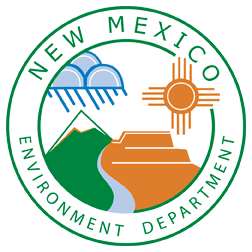What is the Ozone Attainment Initiative?
NMED is required by New Mexico state statute 74-2-5.3 NMSA 1978 to take action to reduce ozone pollution in counties where ozone levels reach certain thresholds.
The Ozone Attainment Initiative (OAI) has 3 main goals:
- To ensure the health and welfare of current residents and future generations in New Mexico.
- To protect the attainment/unclassifiable status of all areas in the state.
- To develop plans that detail how nonattainment areas will attain and maintain the standards by reducing ozone.
Why do we need the OAI?
The OAI is necessary to keep counties in New Mexico in attainment for ozone. Currently, only the Sunland Park area in southern New Mexico is classified as nonattainment. However, other counties are monitoring increased ozone concentrations, with seven counties* currently exceeding 95% of the ozone standard (shaded red in the map below).
Note that elevated ozone levels in Bernalillo County are monitored by the City of Albuquerque/Bernalillo Air Quality Division, which is working to reduce ozone in this county.
If these counties are designated as being in nonattainment by the Environmental Protection Agency (EPA), it would trigger planning requirements including a stringent, costly, and lengthy air permitting process.
Nonattainment areas require air quality permits to include lowest achievable emission rate technology and permit emission offsets for any new or modified operations. Offsets are emission reductions, generally obtained from existing sources located in the vicinity of a proposed source, that must (1) offset the emissions increase from the new source or modification and (2) provide a net air quality benefit. By requiring emission reduction offsets, a nonattainment area can still allow some industrial growth while moving toward attainment of the NAAQS. (Source:https://www.epa.gov/nsr/nonattainment-nsr-basic-information).
Ozone Fact Sheets
- Ozone Monitoring in New Mexico describes ozone monitor locations and concentrations and the Ozone Attainment Initiative.
- Ozone Pollution Health Effects describes the negative health effects of ground-level ozone.
Developing Regulations
NMED is relying upon a combination of mandatory state and federal regulations as well as voluntary public participation measures to reduce ozone concentrations in the state.
NMED is mandated to develop a draft rule according to the directives in the New Mexico Air Quality Control Act. The draft rule establishes emissions standards for volatile organic compounds (VOC) and oxides of nitrogen (NOx), ozone precursor pollutants, for oil and gas production and processing sources located in areas of the state within the Environmental Improvement Board’s (EIB) jurisdiction where ozone concentrations are exceeding 95% of the national ambient air quality standard.
Find more information on the Ozone Precursor Rule here.
In addition to state rules, NMED relies on existing federal regulations targeted at reducing ozone precursor pollutant emissions.
Standards of Performance for New Stationary Sources (NSPS) 40 CFR Part 60 are federal regulations already in place that control NOx and VOC emitted from oil and gas facility equipment.
- Subpart GG – Standards of Performance for Stationary Gas Turbines
- Subpart IIII – Standards of Performance for Stationary Compression Ignition Internal Combustion Engines
- Subpart JJJJ – Standards of Performance for Stationary Spark Ignition Internal Combustion Engines
- Subpart K, Ka, Kb – Standards of Performance for Storage Vessels for Petroleum Liquids for which Construction, Reconstruction, or Modification Commenced after 6/11/1973 & prior to 5/19/1978; after 5/18/1978 & prior to 7/23/1984; and after 7/23/1984, respectively
- Subpart KKK – Standards of Performance for Equipment Leaks of VOC from Onshore Natural Gas Processing Plants for which Construction, Reconstruction, or Modification Commenced after 1/20/1984 and on or before 8/23/2011
- Subpart KKKK – Standards of Performance for Stationary Combustion Turbines
- Subpart OOOO and OOOOa – Standards of Performance for Crude Oil and Natural Gas Facilities for which Construction, Modification, or Reconstruction Commenced after 8/23/2011 and on or before 9/18/2015
National Emission Standards for Hazardous Air Pollutants (NESHAP) 40 CFR Part 63 are federal regulations already in place that control hazardous pollutants emitted from oil and gas facility equipment.
- Subpart HH – National Emission Standards for Hazardous Air Pollutants from Oil and Natural Gas Production Facilities
- Subpart HHH – National Emission Standards for Hazardous Air Pollutants for Natural Gas Transmission and Storage
- Subpart YYYY – National Emission Standards for Hazardous Air Pollutants for Stationary Combustion Turbines
- Subpart ZZZZ – National Emission Standards for Hazardous Air Pollutants for Stationary Reciprocating Internal Combustion Engines
NMED participates in the voluntary Ozone Advance Program, which is a collaborative effort to encourage ozone emission reductions in attainment areas. Through this program, states, tribes and local governments work with EPA to take near-term steps to improve local air quality and ensure continued health protection over the long term. The goal is to avoid violations of a NAAQS and maintain an attainment designation. NMED has developed the Ozone Advance Path Forward to encourage ozone reductions. Additional information and opportunities for stakeholder input will be available in the near future.
Stakeholder involvement
NMED prioritizes and has a robust history of stakeholder involvement. Stay connected with your Air Quality Bureau regarding important regulatory information and public participation opportunities. Sign up to receive notification of timely, must-read information directly to your e-mail, and check out the Department calendar to stay up-to-date.

